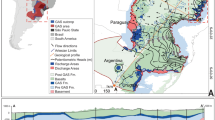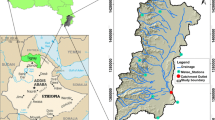Abstract
Depiction of terrestrial water flux constituents in respect of geospatial distribution and consecutive disparity are important for water resources assessment. Due to the excessive and indiscriminate withdrawal of groundwater (GW), the water table (WT) in Dhaka area is continuously depleting during the last few decades. The consequences of increasing water scarcity being a grave concern for the policymakers of the country become a serious issue to save Dhaka areas from its possible failure in terms of human survivability and sustainability. These challenges set the urgency and great importance for holistic assessment of GW resources in the present context. GW recharge is estimated using combined Water Balance approach, Groundwater Estimation Committee methodology, and empirical technique. The monsoon and non-monsoon rainfall recharges (RRM and RRNM) are found as 63% and 37% in Dhaka City; and 55% and 45% in Dhaka district areas. The contributions for overall GW recharge in Dhaka City and Dhaka district from rainfall (RRAnl), water bodies (RSW), return flow (RRFD), and unaccounted recharge (RUAc) are 40.2% and 59.1%; 8.6% and 23.26%; 39.1% and 17.64%; and 12.1% and 0% in 1996, respectively. These have been altered as 22.1% and 55.9%; 2.8% and 16.2%; 37.6% and 27.9%; and 37.5% and 0% in 2015, respectively. It is observed that the total GW recharge in Dhaka City and Dhaka district has altered from 590 and 440 mm in 1996 to 730 mm and 422 mm in 2015, respectively. But the water draft due to domestic, private and industrial use in Dhaka City has increased from 726 and 373 mm in 1996 to 1092 and 582 mm in 2015, respectively. The water draft due to irrigation, and private & industrial use in Dhaka district is found as 256 and 110 mm in 1996 to 1369 and 166 mm in 2015, respectively. The seasonal WT fluctuation varies from 1.1 to 2.3 m in falling trend except Dhaka City where no significant variations are observed. The WT in Dhaka City has depleted from 17 m bgl with a rate of 1.5 m/year in 1996 to 63 m bgl in with a rate of 3.2 m/year in 2015. The WT in Dhaka district has been uplifted from 6.4 m bgl with a rate of 0.82 m/year in 1996 and then falling downward at a rate of 0.8 m/year in 2003 and reached to 14.45 m bgl at a rate of 1.52 m/year in 2015. The stage of GW development (SGD) and categorization in Dhaka City fall within 172–208% as ‘vulnerable’ during 1996 which have further aggravated to 229–272% as ‘highly vulnerable’ during 2015. The SGD and categorization in peri-urban area are estimated as 108–112% as ‘overexploited’ during 1996 which has further risen to 150–158% as ‘vulnerable’ during 2015, respectively. But, the condition is better in rural areas where, SGD and categorization are analysed as 61–70% as ‘safe’ in 1996 which has further deteriorated to 108–117% as ‘overexploited’ in 2015.












Similar content being viewed by others
References
Akther H, Ahmed MS, Rasheed KBS (2009) Spatial and temporal analysis of groundwater level fluctuation in Dhaka City, Bangladesh. Asian J Earth Sci 2(2):49–57
Athavale RN, Rangarajan R (1988) Natural recharge measurements in the hard rock regions of semi-arid India tritium injection—a review. Estim Nat Groundw Recharge. https://doi.org/10.1007/978-94-015-7780-9_11
Chattrejee R, Purohit RR (2009) Estimation of replenishable groundwater resources of India and their status of utilization. Curr Sci 96(12):1581–1590
Dhaka Water Supply and Sewerage Authority (DWASA) (2017) Management Information Report (MIR) from January 2001 to July 2016. DWASA, Dhaka
GEC-1997 (2009) Report of the Ground Water Resource Estimation Committee, Ministry of Water Resources, Government of India. http://cgwb.gov.in/documents/gec97.pdf. Accessed 26 June 2018
GEC-2015 (2017) Report of the Ground Water Resource Estimation Committee, Ministry of Water Resources, River Development & Ganga Rejuvenation, Government of India. http://cgwb.gov.in/Documents/GEC2015_Report_Final%2030.10.2017.pdf. Accessed 2 July 2018
Hossain MZ, Nikam BR, Gupta PK, Srivastav SK (2021) Estimating groundwater resource and understanding recharge processes in rapidly urbanizing Dhaka City, Bangladesh. Groundw Sustain Dev 12:100514. https://doi.org/10.1016/j.gsd.2020.100514
Jasrotia AS, Kumar A (2014) Estimation of replenishable groundwater resources and their status of utilization in Jammu Himalaya, J&K, India. Eur Water 48:17–27
Jie Z, van Heyden J, Bendel D et al (2011) Combination of soil-water balance models and water-table fluctuation methods for evaluation and improvement of groundwater recharge calculations. Hydrogeol J 19:1487–1502
Korkmaz N (1988) The estimation of groundwater recharge from water level and precipitation data. J Islam Acad Sci 1(2):87–93
Kumar CP (2012) Assessment of groundwater potential. Int J Eng Sci 1:64–79
Kumar GNP, Srinivas P (2012) Evaluation of groundwater resources and estimation of stage of groundwater development in a basin—a case study. Irrig Drain 61:129–139
Mondal NC, Singh VP (2010) Entropy-based approach for estimation of natural recharge in Kodaganar River basin, Tamil Nadu, India. Curr Sci 99 (11). https://www.researchgate.net/publication/216086923
Mondal NC, Singh VP, Sankaran S (2011) Entropy-based approach for assessing natural recharge in unconfined aquifers from Southern India. Sci Res Essays 6(16):3539–3552. https://doi.org/10.5897/SRE11.659
MPO (Master Plan Organisation) (1987) Groundwater Resources of Bangladesh. Technical Report no 5. Master Plan Organization, Dhaka. Hazra, USA; Sir M MacDonald, UK; Meta, USA; EPC, Bangladesh
MPO (Master Plan Organisation) (1991) Final Report, National Water Plan Project Phase II. Master Plan Organization, Dhaka. Hazra, USA; Sir M MacDonald, UK; Meta, USA; EPC, Bangladesh
Peera DG, Kumar MK (2015) Assessment of groundwater resources: a case study. Int J Adv Eng Technol 8(6):1050–1062
Prasad SY, Rao VB (2018) Groundwater recharge estimation studies in a khondalitic terrain of India. Appl Water Sci 8:102
Rahman MS, Mamtaz R (2018) Modelling of groundwater resources of Dhaka City. Glob Sci Technol J 6(2):64–84
Scanlon BR, Richard H, Cook PG (2002) Choosing the appropriate techniques for quantifying groundwater recharge. Hydrol J 10:18–39
Shahid S, Wang X, Rahman MM, Hasan R, Harun SB, Shamsudin S (2015) Spatial assessment of groundwater over-exploitation in north-western districts of Bangladesh. J Geol Soc India 85:463–470
Shamsudduha M, Taylor RG, Ahmed KM, Zahid A (2011) The impact of intensive groundwater abstraction on recharge to a shallow regional aquifer system: evidence from Bangladesh. Hydrogeol J 19:901–916. https://doi.org/10.1007/s10040-011-0723-4
Acknowledgements
The authors acknowledge the support and encouragement of the authority from Indian Institute of Remote Sensing and Survey of Bangladesh in carrying out this research work.
Author information
Authors and Affiliations
Corresponding author
Additional information
Publisher's Note
Springer Nature remains neutral with regard to jurisdictional claims in published maps and institutional affiliations.
Rights and permissions
About this article
Cite this article
Hossain, M.Z. Groundwater resource assessment using different hydrological methods and GIS techniques for Central Part of Bengal Delta. Sustain. Water Resour. Manag. 7, 19 (2021). https://doi.org/10.1007/s40899-021-00496-x
Received:
Accepted:
Published:
DOI: https://doi.org/10.1007/s40899-021-00496-x




